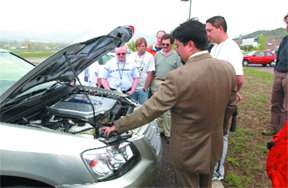 Debates about
energy prices and sources are always simmering. But in August, when oil neared
the $50-per-barrel threshold, the debate quickly began to boil — with renewed
discussion on reducing foreign dependence on oil, improving energy efficiency
at lower cost and decreasing environmental consequences. These goals, two MIT
scientists suggest, are already attainable via one alternative solution: gasoline-electric
hybrids already in the marketplace, such as the Toyota Prius and the Honda Civic
Hybrid.
Debates about
energy prices and sources are always simmering. But in August, when oil neared
the $50-per-barrel threshold, the debate quickly began to boil — with renewed
discussion on reducing foreign dependence on oil, improving energy efficiency
at lower cost and decreasing environmental consequences. These goals, two MIT
scientists suggest, are already attainable via one alternative solution: gasoline-electric
hybrids already in the marketplace, such as the Toyota Prius and the Honda Civic
Hybrid.Staff at the National Renewable Energy Lab examine Toyota’s first “market-ready” hydrogen fuel cell vehicle during a vehicle demonstration in April 2004. A new study says that fuel cell cars and hybrid cars have nearly the same efficiency rating, but that hydrogen fuel cell vehicles are likely many years away from hitting the market. Photo courtesy of Warren Gretz of NREL.
Following the ongoing energy debates in the news, John Deutch and Nurettin Demirdöven decided to run efficiency modeling tests on hybrids and fuel cell cars. Writing in a special Aug. 13 edition of Science dedicated to the topic of the hydrogen economy, they say that the two technologies produced nearly the same efficiency ratings, and both doubled the efficiency ratings of normal passenger cars. They suggest that the science behind hydrogen fuel cells is so far away from being able to mass-produce cars that the government should focus funding on tax incentives for hybrids and improving that technology — thus decreasing the need for oil and reducing emissions now.
The authors’ conclusion is a little short-sighted, says George Sverdrup, manager of hydrogen and fuel cell vehicle technologies at the Department of Energy’s National Renewable Energy Laboratory (NREL) in Colorado. Moving to hybrid internal combustion engines will reduce the quantity of petroleum that the United States uses for transportation and will reduce carbon dioxide emissions now, Sverdrup says. “But as we continue to increase vehicle-miles-traveled each year, our use of petroleum and carbon dioxide emissions will once again be on the rise.” What the United States needs, he says, is both near-term and long-term solutions.
Traditionally, Sverdrup says, the U.S. government’s role has been to fund longer-term, higher-risk research and development, leaving commercialization and deployment of technologies to the private sector. Since 2003, for example, when President Bush unveiled the $1.2 billion Hydrogen Fuel Initiative, the Department of Energy has been working with the private sector to develop the technology needed for commercially viable hydrogen fuel cell vehicles to become available to the public by 2020. A good compromise, Sverdrup says, would be for the government to invest in research and development for higher-risk technologies while also continuing to invest in hybrid technologies and provide tax incentives for consumers.
“In 1992, our goal at NREL was to have a showroom that sold a hybrid on its floor by 2002,” says Terry Penney, advanced vehicles technology manager at NREL, and they met that goal. Ten years from now, he says, the goal is to have entire fleets of hybrid cars.
Although scientists are striving to have a mass-producible hydrogen fuel cell car in 10 to 15 years as well, the more realistic timeline is probably 50 years, Penney says. First, researchers need to work out the many bugs in the system, he says, such as where the hydrogen comes from, what kinds of waste the production of hydrogen leaves behind, how to safely store hydrogen, and infrastructure issues. And the government, auto industry, and oil and gas industries need to get together to do that, Penney says. Thus, getting more hybrids on the roads now is a good interim goal.
However, Deutch and Demirdöven write, consumers will not begin buying hybrids en masse until either prices decrease or the government offers more subsidization. Currently, the federal government offers a $1,500 tax credit for people who buy hybrids, but that program is set to phase out over the next three years.
Indeed, price is one of the main reasons that consumers give for not buying hybrids, says Anthony Pratt, a senior manager at J.D. Power and Associates. Hybrids average $3,400 more than their standard counterparts. Until the price comes down, Pratt says, the other reasons for buying a hybrid — including reducing dependence on foreign oil, reducing vehicle pollutants, doing something good for the environment and saving gas money — will not push people over the edge.
Even when gas prices hover nationwide around $2.00 a gallon, consumers are not likely to switch. J.D. Power statistics show that without other incentives, consumers are not likely to change their behavior until gas prices hit $3.50 or $4.00 a gallon. Department of Energy statistics show that number to be closer to $5.00 a gallon, Penney says.
“The whole thing has to be looked at from the all-important consumer’s perspective,” Penney says. In the end, he says, whether or not hydrogen cars ever get on the roads or hybrids become more than a niche market is up to public perception and what people feel.

